Skin and Skin Conditions
Tin Miners Don’t Get Pimples!
Sure, they had to work in hot, stifling conditions. They frequently suffered from bronchitis, silicosis, TB and rheumatism. Rock falls, flooding, and arsenic poisoning were constant dangers. (Arsenic being a by-product of tin mining). But they didn't get pimples. So life was good.
[info about the dangers of tin mining from bbc.co.uk]
Posted By: Alex - Sat May 18, 2013 -
Comments (1)
Category: 1950s, Diseases, Skin and Skin Conditions
Herpits

Make your visit now!
Posted By: Paul - Fri Feb 22, 2013 -
Comments (5)
Category: Body, Skin and Skin Conditions, Hygiene, Asia
Permadontics
I don't normally pay much attention to banner ads, but my eye was drawn to this one. Why, I wonder, is the person's face a bright shade of purplish-red like a boiled lobster? Is that a side-effect of whatever treatment this company is offering, or just a poor choice of model?
Posted By: Alex - Wed Jun 20, 2012 -
Comments (6)
Category: Advertising, Skin and Skin Conditions
Workers’ Hands
From "The Worker's Hand" by George Rosen, M.D. in Ciba Symposia (July 1942).As someone who's spent too much time at a keyboard during my life, resulting in bad carpal tunnel syndrome, I can definitely empathize with these hands abused and deformed by work.
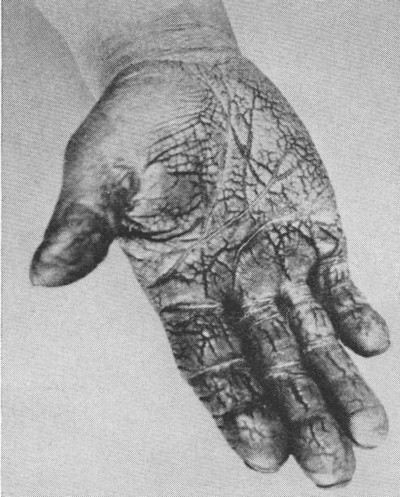
A tanner. Creases deeply stained.
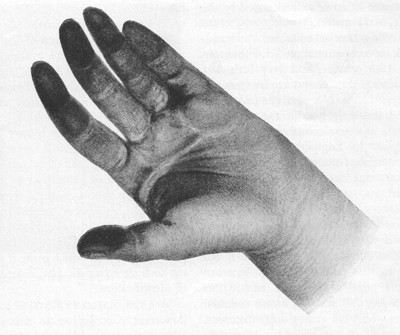
Walnut sheller. Stained fingers.
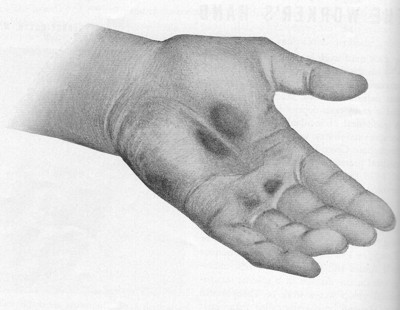
Wood carver. Oval callouses in the center of the palm.
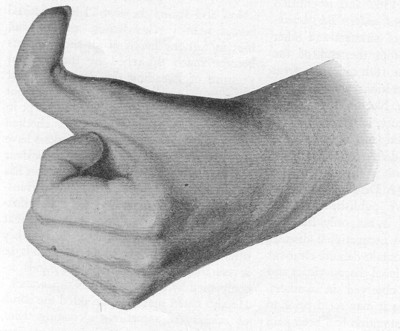
Jeweler. Dislocated distal phalanx of the thumb.
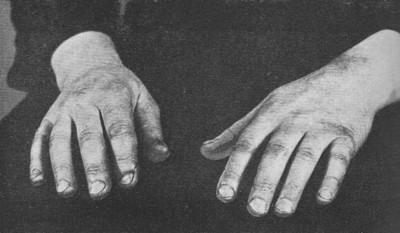
Glass polisher. Shortened, brittle nails.
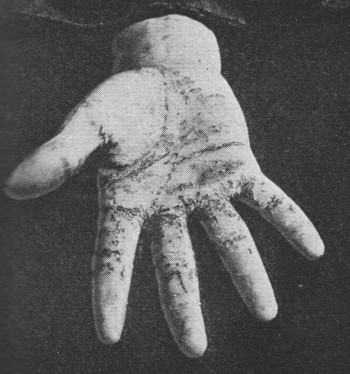
Metal worker. Penetration of metal particles into the skin.
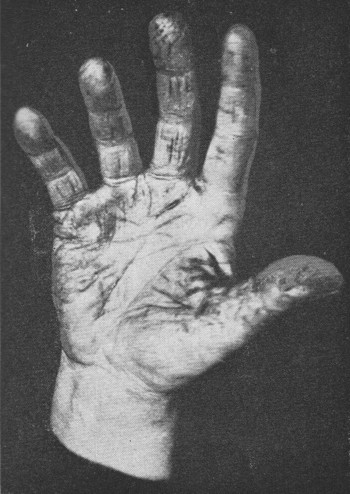
Worker in a glass factory. Callosities produced by mechanical work.
Posted By: Alex - Mon Jun 18, 2012 -
Comments (14)
Category: Jobs and Occupations, Skin and Skin Conditions
The See-through Flesh of Heavenly Virgins
Posted By: Paul - Sat Jun 09, 2012 -
Comments (15)
Category: Frauds, Cons and Scams, Religion, Sexuality, Skin and Skin Conditions
Geoff Ostling wants his tattooed skin hung on a gallery wall as art after he dies
Retired teacher Geoff Ostling is covered in tattoos by Australian artist eX de Medici. He likes them so much that he wants them to be preserved for posterity. So he's bequeathed his skin to the National Gallery in Canberra so that after he's dead it can be tanned and hung on the wall for everyone to see. The Gallery hasn't accepted it yet, and Ostling realizes the bequest is controversial, but he thinks the controversy is a result of people being overly squeamish: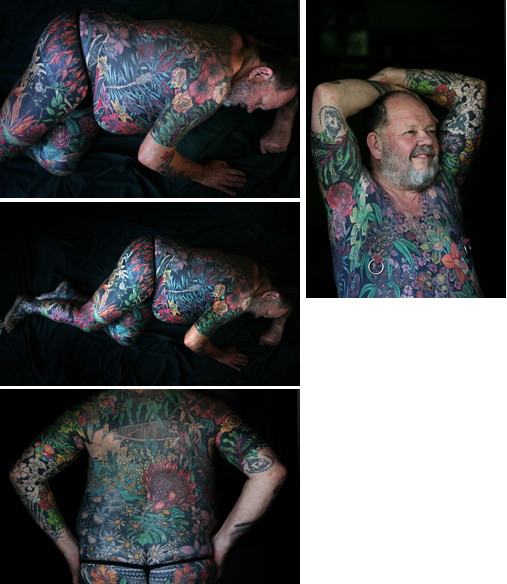
Images via zimbio.com
Posted By: Alex - Fri Jun 01, 2012 -
Comments (12)
Category: Art, Skin and Skin Conditions
Dr. Scott’s Electric Flesh Brush

It rubs the Flesh Brush on its skin!
From Scientific American, Sep 17, 1881.
If interested, you can buy a genuine Flesh Brush on eBay, for a mere $174.95.
Posted By: Alex - Sun May 20, 2012 -
Comments (4)
Category: Advertising, Products, Skin and Skin Conditions
Fingernail Surgery To Remove Seborrheic Keratoses
The medical rule I've heard is that you're not supposed to pick at zits or skin growths, because you'll only make them worse — or cause an infection. But apparently this rule doesn't apply to seborrheic keratoses. According to Dr. George Lundberg, Editor in Chief of MedGenMed, go ahead and pick 'em. Or rather, use "fingernail surgery" to remove 'em. That's what he does!However, Lundberg's advice hasn't met with universal approval from the medical community. Among the resonses to his editorial on MedGenMed is this one:
I find your piece embarrassing and unworthy of your Internet service.
If you had bothered to do some research, even just reading eMedicine, you would find that curettage, not excision, is the recommended treatment -- a far more sterile version of a fingernail surgery. The curettage procedure is usually nonscarring though rarely some mild hypopigmentation may result.
The use of fingernail surgery is to be condemned as it is a bacterially contaminated area.
Picking at one's own skin with the fingernails is a bad habit and in its extreme form can become obsessive and result in scarring -- a disorder known as neurotic excoriation.
Many elderly gentlemen will pick at solar keratoses on their scalp, leaving it in a persistent state of bleeding and infection; I sincerely hope that you are not headed in this direction.
If your medical colleagues excise your seb warts or cause significant scars, or if you suspect that they choose their therapies on the basis of cost benefit to themselves, I suggest you take the matter up with your State Medical Board rather than indulging in self-injury.
If there is any doubt about the diagnosis, the curetted specimen can be sent for pathology.
Cheers,
Philip Bekhor
Melbourne, Victoria, Australia
Posted By: Alex - Wed Mar 28, 2012 -
Comments (9)
Category: Health, Medicine, Surgery, Skin and Skin Conditions
Smelly Hands
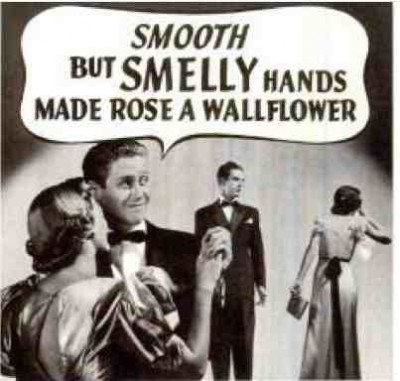
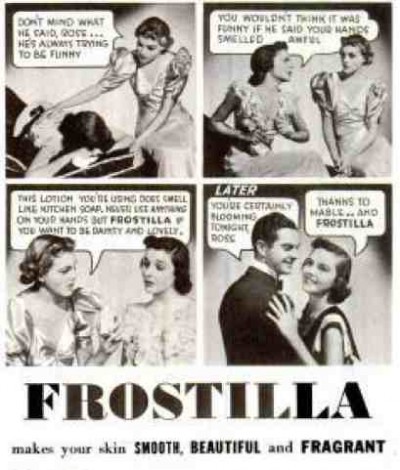
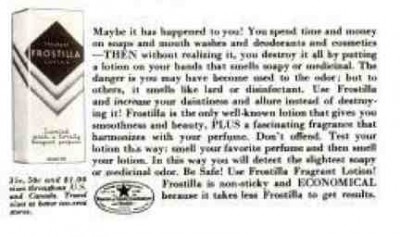
Is this a common problem among ladies?
Original ad here.
Posted By: Paul - Thu Feb 02, 2012 -
Comments (4)
Category: Body, Skin and Skin Conditions, Business, Advertising, Products, Public Humiliation, Unsolved Mysteries, 1930s
The Wellcome Collection
This might be a museum WU-vies wish to visit when they are next in London.
Home page.
PS: if I shut my eyes and just listen to this video, why do I think I'm hearing the cast of A Hard Day's Night?
Posted By: Paul - Mon Jan 23, 2012 -
Comments (4)
Category: Body, Skin and Skin Conditions, Eccentrics, Museums, Weird Studies and Guides

| Who We Are |
|---|
| Alex Boese Alex is the creator and curator of the Museum of Hoaxes. He's also the author of various weird, non-fiction, science-themed books such as Elephants on Acid and Psychedelic Apes. Paul Di Filippo Paul has been paid to put weird ideas into fictional form for over thirty years, in his career as a noted science fiction writer. He has recently begun blogging on many curious topics with three fellow writers at The Inferior 4+1. Contact Us |





